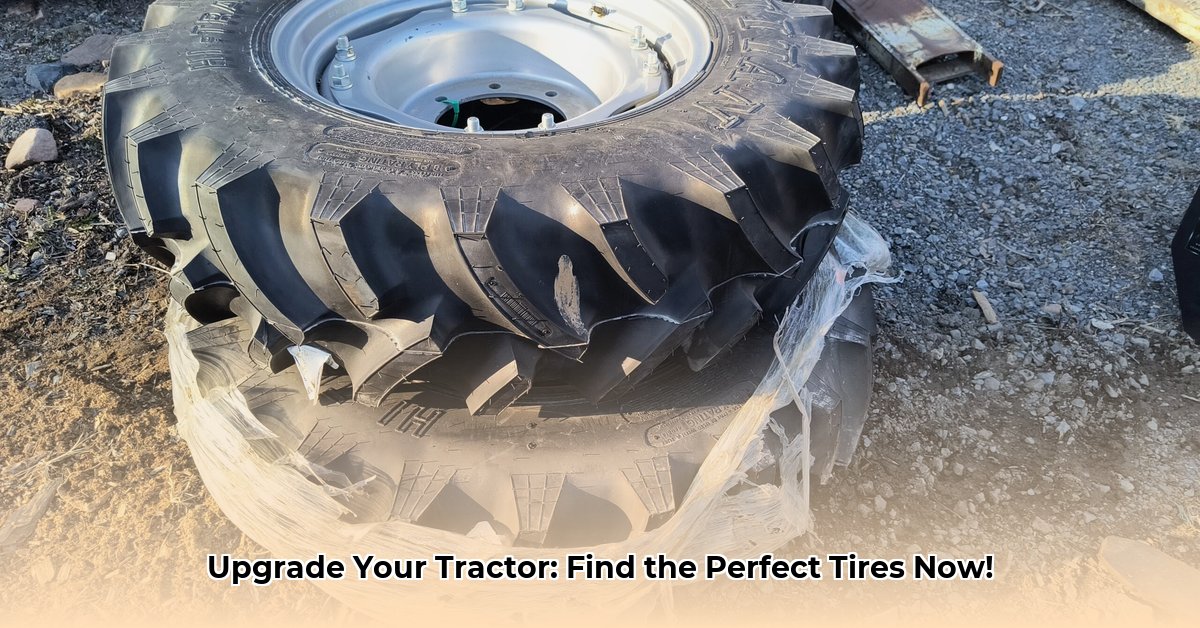
Choosing the right 12.4 tractor tires is a crucial decision impacting farm efficiency, sustainability, and profitability. This detailed guide helps you navigate the complexities of tire selection by providing actionable advice and a comparative analysis of tire options. For information on other tractor tire sizes, check out this helpful resource on different tire sizes.
Understanding 12.4-24 Tractor Tires
12.4-24 tractor tires are a common size for smaller to medium-sized tractors, designed for various terrains and tasks. However, several key features differentiate one tire from another.
Key Features to Consider:
- Load Capacity (the maximum weight a tire can safely support): Overloading leads to premature wear and potential damage. Ensure the tire's load capacity matches or exceeds your tractor's weight and typical loads.
- Rolling Resistance (the force resisting a tire's motion): Lower rolling resistance translates to better fuel economy and reduced operational costs. This is a crucial factor for long-term cost savings.
- Tread Pattern (the design of the tire's surface): Different patterns (e.g., R-1, R-1W, R-2, R-3, R-4) are optimized for different soil conditions. Selecting the right pattern is critical for maximizing traction and minimizing soil compaction. Deep treads excel in muddy or wet conditions, while shallower treads are better suited for drier environments.
Aren't lower rolling resistance tires always the best option? While lower rolling resistance generally means better fuel economy, it sometimes comes at the cost of traction. Finding the right balance for your specific needs is crucial.
Comparative Analysis: Premium vs. Budget Tires
The market offers numerous 12.4-24 tractor tires, ranging from premium brands to budget-friendly options. The following table compares typical features:
| Feature | Premium Brand | Budget-Friendly Brand |
|---|---|---|
| Price | Significantly Higher | Lower |
| Performance | Generally superior, longer lifespan | May show wear and tear sooner |
| Rolling Resistance | Usually lower, improves fuel efficiency | Potentially higher, impacting fuel economy |
| Tread Durability | More robust, resists wear and tear | May wear down more quickly |
| Warranty | Typically longer and more comprehensive | Shorter duration or more limited |
Important Note: Reliable performance data can be difficult to find. Independent reviews, user feedback, and discussions within farming communities are invaluable resources for supplementing manufacturer claims.
Sustainability Considerations: The Environmental Impact
Sustainable agriculture requires mindful tire choices. While comprehensive data on the environmental impact of tire production and disposal is scarce, we can focus on:
- Tire Lifespan: A longer-lasting tire reduces waste and the frequency of replacements.
- Material Sourcing: Increased transparency from manufacturers would allow us to assess the sustainability of tire materials.
- Disposal: Explore environmentally responsible tire recycling and disposal options. Advocate for improved recycling infrastructure.
How can farmers contribute to more sustainable tire practices? By demanding more transparency from manufacturers regarding material sourcing and lifecycle impacts and advocating for improved tire recycling programs.
Decision-Making Guide: A Step-by-Step Approach
Choosing the best tires involves several steps:
- Assess Your Needs: Identify your priorities (budget, performance, sustainability). Consider soil conditions, typical workloads, and operational costs.
- Set a Realistic Budget: Determine your investment capacity, remembering to consider the entire lifecycle of the tire.
- Research Different Brands and Models: Compare prices, performance claims, and user reviews from multiple reliable sources.
- Check Load Capacity and Rolling Resistance: Ensure the tire can safely handle your tractor's weight and typical loads. Prioritize lower rolling resistance for fuel efficiency.
- Consider the Tread Pattern: Select a tread pattern that optimizes traction for your soil conditions.
- Make an Informed Decision: Weigh cost, performance, and environmental impact to find the best fit. Consult with your local tire dealer for personalized expert advice.
Do you know how much fuel you could save annually by choosing tires with lower rolling resistance? The savings can be substantial, potentially offsetting the higher initial cost over the tire's lifespan.
Tire Maintenance: Maximizing Lifespan and Performance
Proper maintenance is crucial for extending tire lifespan:
- Regular Inspections: Check for cuts, punctures, uneven wear, and embedded debris.
- Proper Inflation: Maintain the correct tire pressure as specified by the manufacturer for optimal performance, fuel efficiency, and longevity.
- Periodic Rotation: Rotate tires regularly to promote even wear.
- Appropriate Storage: Store tires properly during the off-season to prevent damage.
Conclusion: Choosing Wisely for a Sustainable Future
Selecting the right 12.4 tractor tires involves a careful evaluation of cost, performance capabilities, and environmental impact. By following the steps outlined in this guide, farmers can make informed decisions that optimize operational efficiency and promote sustainable agricultural practices, ultimately benefitting both their bottom line and the environment. Remember – a well-informed tire purchase is an investment in your farm's long-term prospects.